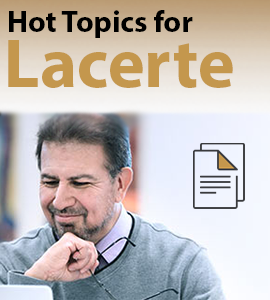- Topics
- Training
- Community
- Product Help
- Industry Discussions
- User Groups
- Discover
- Resources
- Intuit Accountants Community
- :
- Lacerte Tax
- :
- Lacerte Tax Discussions
- :
- Balance Sheet 179D credit for S-Corp Architect
Balance Sheet 179D credit for S-Corp Architect
- Mark Topic as New
- Mark Topic as Read
- Float this Topic for Current User
- Bookmark
- Subscribe
- Printer Friendly Page
- Mark as New
- Bookmark
- Subscribe
- Permalink
- Report Inappropriate Content
I have an architect client who designs schools. Had a 179D energy efficiency study done and got him a nice expense deduction that I understand he can claim on the S-Corp P&L and pass through to his personal return.
My question is on the balance sheet on the return. The expense is a debit. What's the credit in my journal entry to record this? He's over the reporting threshold, so he has to fill out Schedule L and complete a Balance Sheet.
My client doesn't own the building (a high school), so he can't reduce his basis in that. Is it just to equity, so essentially a capital contribution?
I've tried researching this, and can find a lot on the credit as well, but haven't found anything that addresses this item.
Best Answer Click here
![]() This discussion has been locked.
No new contributions can be made. You may start a new discussion
here
This discussion has been locked.
No new contributions can be made. You may start a new discussion
here
Accepted Solutions
- Mark as New
- Bookmark
- Subscribe
- Permalink
- Report Inappropriate Content
It's a Schedule M book-tax difference, I believe.
- Mark as New
- Bookmark
- Subscribe
- Permalink
- Report Inappropriate Content
Hope your client is aware, for the credit he needs an independent, third-party firm to review the building to confirm the energy savings and potential tax deduction. Also , for businesses that are seeking 179D based on work performed on government-owned buildings, these companies are required to secure an allocation letter that allows the government entity to transfer the benefit to the taxpayer. I know this doesn't answer your Question, but maybe @TaxGuyBill will help out.
- Mark as New
- Bookmark
- Subscribe
- Permalink
- Report Inappropriate Content
Thank you Terry. Yes, we used National Tax Group to confirm the energy savings, and my client did secure an allocation letter.
- Mark as New
- Bookmark
- Subscribe
- Permalink
- Report Inappropriate Content
I found you these resources:
"For firms structured as passthrough entities, the deduction at the entity level reduces the owners’ aggregate tax basis in the entity interest. This deduction, however, does not consume cash. (Consider it a “free” deduction.) The entity has the same cash available for distribution to its owners, but the owners’ tax bases in the entity have been reduced due to the passthrough deduction. Ultimately, the owners will have capital gain from receiving distributions in excess of tax basis (Sec. 704(d) for partnerships and Sec. 1366(d) for S corporations). The effect of Sec. 179D: A “free” current ordinary deduction is provided to the designer at the cost of a future capital gain. Sec. 179D provides a benefit to the designer, but it is not as much of a benefit as it initially appeared.
For designers structured as S corporations, the possibility exists that the S corporation has accumulated earnings and profits from a C corporation year. The Sec. 179D deduction reduces the accumulated adjustments account, thereby causing cash distributions to be dividends to the extent of accumulated earnings and profits.
The IRS Office of Chief Counsel released legal memorandum AM 2010-007 on December 23, 2010, discussing the issue. The memorandum states:
We understand that a growing number of [owners of passthrough entities] . . . have taken the position that this deduction is available to the [owners] without regard to the basis limitation rules contained in §§ 704(d) and 1366(d), either on the theory that the deduction is a partner or shareholder level deduction, or because the basis limitations of §§ 704(d) and 1366(d) and basis adjustment rules of §§ 705(a) and 1367(a) simply do not apply with respect to the §179D deduction.
The memorandum proceeds to give the Office of Chief Counsel’s position with respect to such arguments, stating that the Sec. 179D deduction, “like any other partnership or S corporation item of deduction,” reduces the owner’s tax basis in the ownership interest. Examples of the effect are provided."
https://www.walkerreid.com/learn-about-179d/
www.walkerreid.com/wp-content/uploads/2015/07/Mem-2010_007-LLC.pdf
Don't yell at us; we're volunteers
- Mark as New
- Bookmark
- Subscribe
- Permalink
- Report Inappropriate Content
Thank you, I had seen this in my research. The sentence "Ultimately, the owners will have capital gain from receiving distributions in excess of tax basis" is what makes me think I'm wrong in crediting equity for the other side of the AJE, because that would preserve his basis.
Client does not have accumulated E&P because he incorporated and elected S immediately after (on 1/1/2012).
- Mark as New
- Bookmark
- Subscribe
- Permalink
- Report Inappropriate Content
It's a Schedule M book-tax difference, I believe.
- Mark as New
- Bookmark
- Subscribe
- Permalink
- Report Inappropriate Content
Thank you so much!
- Mark as New
- Bookmark
- Subscribe
- Permalink
- Report Inappropriate Content
So the municpal building Sec 179D deduction is recorded as oridinary deduction on the 1120S with just a M-1 adjustment with no journal entry required?
- Mark as New
- Bookmark
- Subscribe
- Permalink
- Report Inappropriate Content
Correct!
- Mark as New
- Bookmark
- Subscribe
- Permalink
- Report Inappropriate Content
I found these topics:
Don't yell at us; we're volunteers





